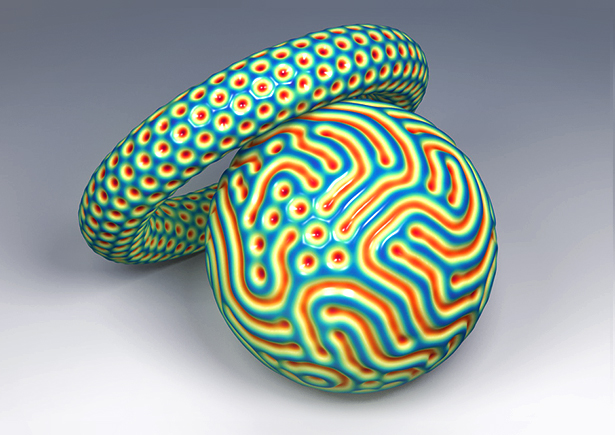A collaboration between mechanical engineers and mathematicians has revealed universal rules for how wrinkles form.

Norbert Stoop
Under pressure, curved surfaces transition from a regular, dimpled pattern to one with irregular wrinkles.Pedro Reis, an engineer at the Massachusetts Institute of Technology, had long been interested in how things wrinkle. For example, a dimpled surface like that of a golf ball offers less air resistance than a smooth sphere. If a flying object could dimple or wrinkle on command, Reis thought, it could alter its own aerodynamics midflight.Also at Quanta:
Reis constructed silicone test spheres and sucked air out of them. He noticed that under pressure, some of the spheres formed the dimples he wanted, but some formed squiggly, labyrinthine patterns instead. Some had both dimples and labyrinths. When a member of his group shared the puzzle with mathematicians at MIT, they were intrigued: The wrinkling patterns resembled the stripes and swirls that appear when you heat a thin layer of oil, a phenomenon called Rayleigh–Bénard convection. Those phenomena had simplified, calculable equations — so why shouldn’t wrinkles have a simplified equation too?
Earlier researchers had worked backwards from specific wrinkling effects to create simulations that worked in single cases, but nobody had simplified the full elastic equations from the ground up to describe all wrinkling behavior — there was not yet a universal theory of wrinkles. It had been unclear which of the many variables were important.
Reis and the mathematicians started to go over the detailed body of experiments that Reis’s group had assembled. When they examined the data from the rubbery spheres, the researchers found that just two factors controlled the formation of patterns: the curvature of a lower layer as compared to the thickness of the wrinkling layer on top, and the stress applied to that wrinkling layer. Films over less-curved surfaces would quickly transition to hybrid or labyrinth forms when put under stress. Setups that were more curved with a thicker layer on top would form a hexagonal layout of dimples and then, if stressed enough (as when Reis pulled air from inside the spheres), would eventually go labyrinthine as well. Releasing the stress would transition the surface back. “What’s interesting is not just that these two parameters are important, but that all the other parameters are not important,” said Norbert Stoop, one of the MIT mathematicians. The researchers found that the stiffness of the wrinkling layer, for instance, has no effect on the outcome. “Our theory you could basically apply to the surface of the moon or Mars, or the surface of a grape.” ...MORE
A mathematician who has analyzed card shuffling for decades is tackling one final nemesis: “smooshing.”